
Salome is a one-act tragedy by Oscar Wilde. The original version of the play was first published in French in 1893; an English translation was published a year later. The play depicts the attempted seduction of Jokanaan by Salome, stepdaughter of Herod Antipas; her dance of the seven veils; the execution of Jokanaan at Salome's instigation; and her death on Herod's orders.
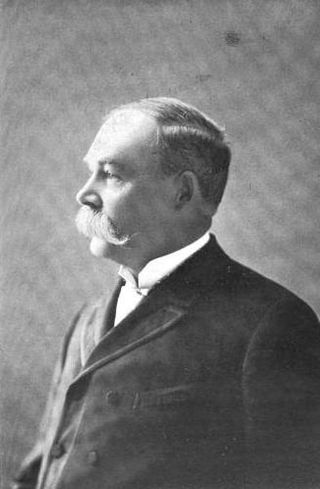
James Edward Boyd was an Irish-born American businessman and politician in early Omaha, Nebraska. The founder of Boyd's Packing House and Boyd's Theater and Opera House, he served as the Mayor of Omaha from 1881 to 1883 and from 1885 to 1887, and as the seventh Governor of the state of Nebraska in 1891 and from 1892 – 1893.
Technical High School (Tech) was a public high school that was located at 3215 Cuming Street in Omaha, Nebraska, United States. Opened in 1923, it was said to be the largest high school west of Chicago and the largest in the Omaha area before it was closed in 1984. Today the building serves as the headquarters of Omaha Public Schools.

Miller Symphony Hall is a 1,100-seat performing arts facility in Allentown, Pennsylvania that hosts the Allentown Symphony Orchestra. The hall was previously known as Central Market (1896), Lyric Theater (1899), and Allentown Symphony Hall (1959). In 2012, it was renamed for the Miller family, longtime owners of the hall and of The Morning Call newspaper.
Joe Coe, also known as George Smith, was an African-American laborer who was lynched on October 10, 1891, in Omaha, Nebraska. Overwhelmed by a mob of one thousand at the Douglas County Courthouse, the twelve city police officers stood by without intervening. Afterward, the mayor called the lynching "the most deplorable thing that has ever happened in the history of the country."

The Bradford–Pettis House is a historic house located at 400 South 39th Street in Midtown Omaha, Nebraska. It was designated an Omaha Landmark on February 26, 1980, and added to the National Register of Historic Places on July 21, 1983.

Tourism in Omaha, Nebraska, United States offers visitors history, sports, nature and cultural experiences. Its principal tourist attractions are the Henry Doorly Zoo and the College World Series (CWS). A 2003 study by a Creighton University economist estimated that the CWS added $33.8 million to the city's economy that year. With 1.1 million visitors annually, the Henry Doorly Zoo is Nebraska's most popular tourist attraction. In 2007 Omaha hosted the USA Roller Sports National Championships, along with 10,000 people who auditioned for the American Idol television show at Qwest Center Omaha.

The Herndon House, later known as the International Hotel and then the Union Pacific Headquarters, was an early hotel located at 9th and Farnam Streets in present-day Downtown Omaha, Nebraska. Built in 1858 by Omaha pioneer Dr. George L. Miller along with several associates, it was financed by the sale of city-donated land and a $16,000 loan. It was used as the headquarters building of the Union Pacific Railroad for more than 50 years; it was demolished in 1922.
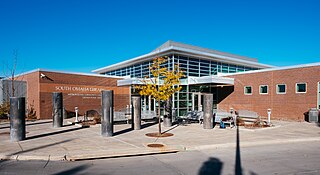
The original Carnegie South Omaha Public Library, designed by Thomas R. Kimball, was built in 1904 at 23rd and M Streets in South Omaha, Nebraska. A Carnegie library, it was razed in December 1953; a new library constructed in the same spot opened in October 1954. The second library building was officially closed on May 17, 2008, when a new branch was opened at 2808 Q Street.
Mendelssohn, Fisher and Lawrie was a significant architecture firm in early Omaha, Nebraska. Fisher & Lawrie continued. A number of their works are listed on the National Register of Historic Places.
Broadway Across America (BAA) is a presenter and producer of live theatrical events in the United States and Canada since 1982. It is currently owned by the John Gore Organization, which purchased it from Live Nation in 2008.
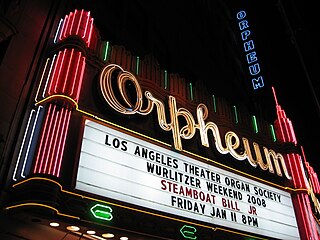
The Orpheum Circuit was a chain of vaudeville and movie theaters. It was founded in 1886, and operated through 1927 when it was merged into the Keith-Albee-Orpheum corporation, ultimately becoming part of the Radio-Keith-Orpheum (RKO) corporation.
Rocheford & Gould were brick manufacturers and construction contractors in early Omaha, Nebraska. The firm built numerous brick structures during Omaha's transition from the wooden buildings of Nebraska's territorial days to more permanent structures. The buildings the firm built included breweries, schools, packing houses, business blocks, Vaudeville theaters, street car barns and power houses, and civic buildings. Many of the structures the firm built have been demolished but a few of their earliest structures still exist and are listed on the National Register of Historic Places.
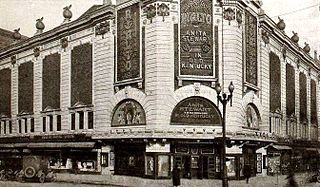
The Rialto Theater was a movie theater at 1424 Douglas Street in Downtown Omaha, Nebraska. The building was razed in 1986 and the site paved over for use as a parking lot. The property was later redeveloped as part of the construction of the Union Pacific Railroad's headquarters building.
The World Theater was a vaudeville and movie theater at 1506 Douglas Street in downtown Omaha, Nebraska. Its name was changed to the Omaha Theater in February 1935 when it was sold to new management. It closed on February 26, 1978, and was razed in 1980 to allow for the construction of a parking garage.
The Moon Theater was a silent movie theater at 1410 Douglas Street in Downtown Omaha, Nebraska. The 1,600-seat theater was built on the site of Omaha's first movie theater, the Parlor. In later years the theater was renamed the Town Theater and eventually the Cooper Theater. The building was demolished in 1976.

Boyd Marshall was an American actor of the stage and screen during the early decades of the 20th century. Born in Ohio in 1884, he moved to New York to pursue a career in acting. He began on the stage and in vaudeville, before entering the film industry in 1913. He had a brief film career, lasting until 1917, before he returned to the stage.
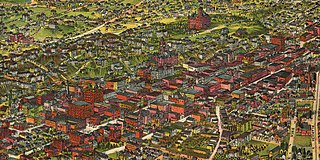
The late-Victorian-era Downtown of Los Angeles in 1880 was centered at the southern end of the Los Angeles Plaza area, and over the next two decades, it extended south and west along Main Street, Spring Street, and Broadway towards Third Street. Most of the 19th-century buildings no longer exist, surviving only in the Plaza area or south of Second Street. The rest were demolished to make way for the Civic Center district with City Hall, numerous courthouses, and other municipal, county, state and federal buildings, and Times Mirror Square. This article covers that area, between the Plaza, 3rd St., Los Angeles St., and Broadway, during the period 1880 through the period of demolition (1920s–1950s).
The history of theaters in Chehalis, Washington started in 1886 with the construction of a mixed-use opera house and town hall, followed by the Tynan Opera House in 1889. The city experienced more than a 50-year stretch of the build or opening of over a dozen theaters and movie houses in the city, culminating with the opening of the Pix Theater in 1938. No further theater was built or established until the opening of a multi-screen cinema at a local shopping center in 1982.












